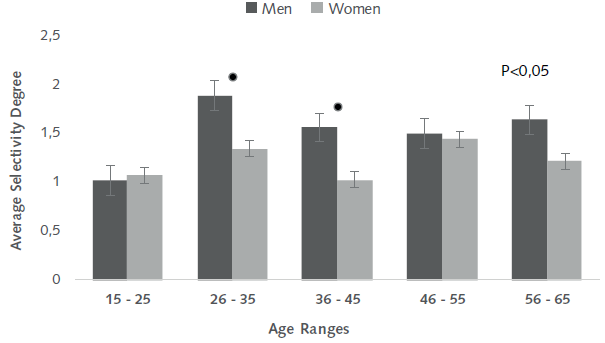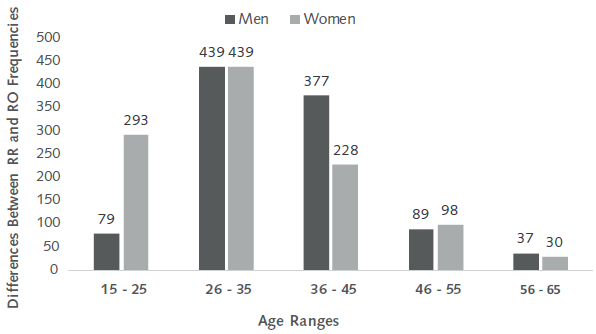MATE CHOICE is recognized as a fundamental process for the species with sexual reproduction because it determines the allocation of significant genetic and energy resources by males and females. Some biology and psychology proposals have tried to deal with specific human reproduction problems, using an evolutionary perspective, as addressed by the theory of sexual strategies (Buss & Schmitt, 1993). This perspective is based on the fact that individuals had to solve adaptive problems related to reproduction. During the evolutionary course of the species, psychological adjustment mechanisms appeared, which are reflected today in the dynamics of search and mate selection (Buss & Schmitt, 1993).
One of the central psychological adaptations to solve the mating problem is preferences (Conroy-Beam & Buss, 2016; Moreno & Gutiérrez, 2021). They initially guide the selection of potential sexual partners based on some general criteria. Conroy-Beam and Buss (2016) suggest that this pattern of preferences is driven by traits that are beneficial for the species' perpetuation.
This approach developed from the theory of sexual selection (Darwin, 1871) and its contemporary additions, the theory of parental investment (Trivers, 1972) and the theory of human sexual strategies (Buss & Schmitt, 1993). It proposes that men and women give priority to traits in their partners that benefit their biological fitness. In other words, each sex tends to mate with individuals who ensure that the offspring will inherit characteristics that facilitate survival or are aesthetically attractive. Those offspring will have a greater probability of reproducing in the future (Miller, 1998).
Evidence from cross-cultural research suggests that humans can adapt to any mating system, including monogamy and polygyny (Buss, 1989; Buss & Schmitt, 2019; Pisanski & Feinberg, 2013; Schmitt, 2014; Shackelford et al., 2005), depending on the socio-cultural context. However, the biological conditions of each sex influence the mating tendency and preferences in different directions. Women would tend to pursue long-term partners and prefer men who provide resources and protection to the family. In contrast, men would tend to engage in short-term relationships and look for fertility signs in women. Such claims have had broad empirical support in recent decades (Buss & Schmitt, 2019; Conroy-Beam & Buss, 2016; Schmitt, 2014; Shackelford et al., 2005).
This pattern of sexual preference is also observed in the majority of mammals, where females tend to be the sex that invests the most, given the costs involved in the gestation and early rearing of offspring, whereas males tend to compete by offering other types of resources, as protection and food (Trivers, 1972).
On the other hand, more recent socio-cultural theories (Zentner & Eagly, 2015) reformulate some of these predictions, stating that cultural conditions promote variations in preference patterns related to the socio-economic conditions and gender roles present in all societies. Those theories suggest inclinations to prefer couples that accommodate restrictions and opportunities that societies impose on the sexes. For example, Zentner and Mitura (2012) show that in societies where men and women have equivalent gender roles and similar socio-economic conditions, there are similar preferences in both sexes in long-term relationships.
In general, the study of preferences for mate selection has been a widely explored topic (Buss & Barnes, 1986; Buss & Schmitt, 2019; Buss et al., 2001; Conroy-Beam & Buss, 2016; Hill, 1945; Lee et al., 2014; Miller, 1998; Russock, 2011; Shackelford et al., 2005; Simpson & Gangestad, 1992; Waynforth & Dunbar, 1995). Based on studies using multiple research methods, common patterns have been found in the preference of characteristics as Kindness/Wellness of relationships, Social Status/ Financial Resources, and Physical Attractiveness/ Health, in the case of long-term mate selection (Shackelford et al., 2005).
However, comparing the research results with different methodological traditions is problematic because different techniques or instruments have some limitations regarding the traits sampling (i.e., what kind of preferences are included), and the other hand, the representativeness of the participants' sample is limited (e.g., university students, AngloSaxon, middle class). In other words, these situations could constrain the possibilities of generalization of the findings (Henrich et al., 2010; Schulz, BahramiRad, Beauchamp & Henrich, 2018).
Thus, it is necessary to expand the existing data on the classification of human preferences in relationships, considering different demographic variables that may affect these preferences' expression in men and women (Zentner & Eagly, 2015). Having regional samples can benefit the scope of predictions of theories interested in explaining human sexual behavior and offers the possibility of evaluating differences and common patterns present in different populations (Henrich et al., 2010).
In some cases, research designs linked to the analysis of dating ads represent advantages by providing ecologically valid data from a wide sample range, that even surpasses local frontiers and connects potential partners living in different regions around the world (Hitsch et al., 2010; Bruch & Newman, 2018).
Regional research evidence on patterns of preference from Latin America and Spain is limited (Burmann et al., 2002; Gutierrez & Carranza, 2016; Hamon & Ingoldsby, 2003; Medina et al., 2008), so analyzing this population may provide valuable information on the expression of mate preferences in the Latino population, that may or may not be consistent with the empirical findings described at this point (Burmann et al., 2002).
This study concentrates on identifying relevant factors or criteria in long-term mate selection preferences, based on a sample of Spanish-speaking consumers of the Colombian edition of Cosmopolitan Magazine, by analyzing personal ads of men and women seeking a long-term partner. This work also aimed to recognize patterns in the distribution of traits that can partially explain how we evaluate the attraction to a potential mate and to what degree these mechanisms fit the theory of sexual strategies (Buss & Schmitt, 1993).
In this research, we expected to identify some of the findings from global studies on preferences in a Spanish-speaking population. In particular, we hoped to replicate some of the results reported by Waynforth and Dunbar (1995) regarding the distribution of preferences and traits offered by each sex in lonely-heart ads, where men prefer physical attractiveness signals and women prefer indicators of status/resources. Also, we expected to see patterns related to the selectivity of each sex according to age, with men ages 30 to 50 increasing their demands.
Besides, this study presents an extensive and flexible system of preference classification through the analysis of the content of the ads, that will help to mitigate the problems of preferences sampling, since these are not usually homogeneous or compatible among different investigations (Conroy-Beam & Buss, 2016; Schmitt, 2014; Shackelford et al., 2005).
In this study, we propose that: (1A) the distribution of sexual preferences in the Spanish-speaking sample is oriented by parental investment and indicators of genetic aptitude, as has been observed in cross-cultural studies; (2A) there are differences in the traits offered and preferred from the overall sample; (3A) there are sexual differences in what kind of traits are offered and preferred by men and women; (3B) mate preferences and requirements are consistent with each sex requests and offers; and (4A) there are sexual differences in mate selectivity.
About the methodological strategy, the analyses of mate searching publications have the advantage of exploring a real or 'natural' context where men and women can have access to many offers of potential partners (i.e., mate market); lonely-hearts ads provide ecologically valid data on the dynamics of mating, that allows the analysis of human reproductive strategies and mate preferences (Greenless & McGrew, 1994; Thiessen et al., 1993).
Furthermore, using this kind of methods allows access to a more diverse sample since users of lonely-heart ads usually have a broader range of demographic characteristics, compared to the university samples used in classical studies. In addition to demographics, information on preferences and characteristics offered by the ads users can also be collected and analyzed. On the other hand, there is a risk of having a biased sample, or the information obtained may be imprecise (Wiederman, 1993).
In this research, a sample of dating publications (between 1988 and 2007) from the "meeting point" section of the Cosmopolitan Magazine (Colombian Edition) was studied. After 2007, there were problems in the regular publication of ads in the magazine, making it difficult to have a consistent database.
Method
A qualitative-quantitative approach was adopted, with a descriptive scope. Qualitative methods were used to extract the information collected in the advertisements, and quantitative analysis was used to examine the general patterns of preferences outlined in the hypotheses.
Unit of Analysis
First, we collected lonely-hearts ads from the "Meeting Point" section of the Colombian edition of Cosmopolitan Magazine. The section collects ads from different places and is not limited to local ads. The data collection was initially prepared by González et al. (2014) in their study on age preferences in mate selection.
The criteria for excluding participants of the sample were adapted according to the objectives and scope of this research. Participants were excluded from the study if they (1) had a homosexual or bisexual orientation; (2) reported interest in having only short-term relationships or friendships; (3) were engaged in a relationship or marriage; (4) did not report age or sex; (5) did not report marital status; (6) did not report preferences (required traits); and (7) duplicated advertisements.
From the extraction of the ads we created a sample of 1468 publications, composed by 52.5 % men and 47.5 % women, with an age range between 16 and 70 years old (M = 35.26; SD = 9.23), who were single 74.52 %, divorced 21.8 %, and widowed 3.68 %. The group is composed of Spanish speakers who report being residents in America, Europe, and Asia.
Procedure
Initially, a pilot study was conducted, based on the extraction of a random sub-set of 100 ads/ descriptions. The objectives were: (a) Examine the inter-coders reliability estimates; (b) construct the coding protocol based on the analysis categories used by Waynforth and Dunbar (1995) in their study with a North American sample of lonely-hearts ads; (c) apply the technique of content analysis to obtain a more detailed classification of the units/traits present in the descriptions of the long-term mating ads of the Cosmopolitan Magazine. Through this technique, emerging categories that grouped some new preferences described by the subjects were identified and compared with factors or critical dimensions in trait preferences reviewed in the literature. (d) evaluate the viability of the coding scheme in order to adapt it to the overall sample and make changes in the final coding system.
Coding system. The coding system (i.e., trait classification scheme) was built based on the concepts proposed in the theory of sexual strategies (Buss & Schmitt, 1993), the theoretical approaches related to indicators of genetic quality (Miller, 1998; Sefcek et al., 2007), and the analytical categories used in Waynforth and Dunbar's (1995) study of mate search publications (See Figure 1 and Table 1).
In summary, the descriptions were organized about the trait presentation of each advertiser (Offered Traits) and the desirable mate characteristics (Required Traits/Preferences). Based on this division, words referring to people's characteristics (e.g., adjectives, descriptions) were coded into six main categories of analysis: Physical Characteristics, Fidelity Indicators, Resources/Status, Parental Commitment, Psychological Attributes, and Miscellaneous.
In the same direction, a classification by subcategories was made to give more precision to the data organization. These categories are directly related to some of the hypotheses derived from evolutionary theories (Buss & Schmitt, 1993; Waynforth & Dunbar, 1995; Sefcek et al., 2007); other emerging categories originate within the context of the analysis of the frequencies of the data in the pilot study phase. The categories at this level are Biological Fitness Indicators, Particular Physical Preferences, Religious Beliefs, Moral Attitudes, Marital Status, Intelligence, Education, Spending Power, Earning Potential, Sense of Humor, Personality Traits/Values*, Interests/Hobbies, and Nationality (See Figure 1 and Table 1).
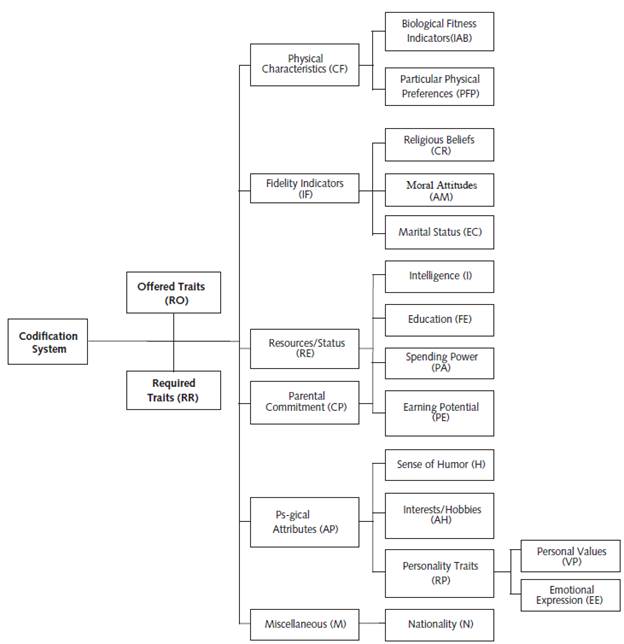
Figure 1 Codification System. Offered (RQ) and Required Traits (RR) have the same Analytical Categories.
Table 1 Description of categories and adjectives used to express preferences in Lonely-Hearts ads.
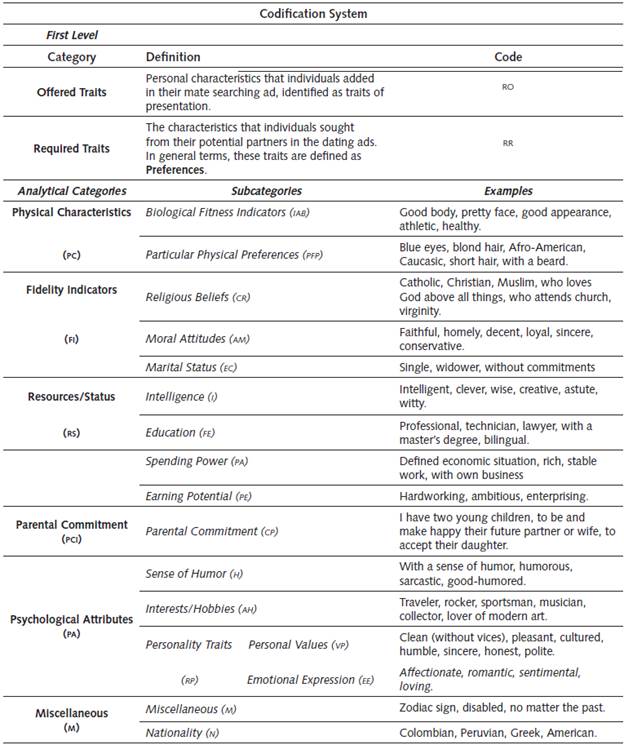
Note. The examples were extracted from the sample of lonely-hearts ads from the Colombian edition of Cosmopolitan Magazine.
Coding process. Initially, a team of four coders (two men and two women) was trained in the research topic and the coding techniques applied in this type of studies; they were also instructed in the use of the qualitative analysis software Nvivo (V.10) that was employed to develop the coding and organization of the final database.
The coding procedure consisted mainly of classifying traits of the mate search publications through the analysis categories. Weekly controls were performed to verify the proper application of the coding protocol.
Data Analysis
Reliability estimates. Reliability estimates were calculated for 4 coders, comparing their performance with the pilot study sample. Cohen's kappa coefficients were estimated for each pair of coders, and an average of 0.85 was obtained, which can be considered an acceptable degree of agreement among the coders (Cohen, 1960).
Comparisons between variables. The percentages of traits coded in the descriptions were calculated based on the categories of traits offered and required, besides the proportions corresponding to each category of analysis and subcategories. Also, statistical comparisons of the offered and required categories and comparisons of categories between sexes and age cohorts were calculated. For such comparisons, Wilcoxon rank tests and U-Mann-Whitney's tests were used. Similarly, Cohens D and Rosenthal's R were estimated to calculate the comparisons' effect size.
In short, comparisons were made between (1) the Offered vs. Required traits; (2) sex comparison in each analysis categories; (3) comparison between age ranges and sexes in the offered and required trait categories. The analyses were conducted with the SPSS (V.25) and R statistical packages (V 3.6.3).
It is necessary to clarify that the effect magnitude indicators' negative values refer to a biased magnitude towards the women's sample. In contrast, the positive values indicate a trend in the data towards the men's sample. Similarly, in the case of comparisons of offered and required traits, positive values of effect magnitude are oriented to the category of offered traits. In contrast, negative values are related to the required traits.
Although the advertisements were in the public domain when the magazine published them, the anonymity of the authors of the ads was guaranteed; their personal data was handled under absolute reserve, as contemplated by the ethical guidelines for research with human participants, contemplated in Law 1090 of 2006 that regulates the professional and research practices of psychologists in Colombia (Congreso de la República de Colombia, 2006).
Results
At first, users reported higher frequencies of mention of Required Traits in the categories Psychological Attributes and Physical Characteristics (See Figure 2); Figures 3 to 6 show the distribution of preferences of the subcategories Psychological Attributes, Physical Characteristics, Fidelity Indicators, and Resources/Status.
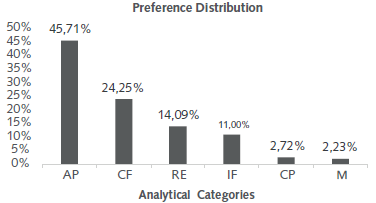
Figure 2 General Catalogue of Preferences. (AP) refers to Psychological Attributes, (CF) Physical Characteristics, (RE) Resources/Status, (IF) Fidelity Indicators, (CP) Parental Commitment, and (M) Miscellaneous.
Moreover, advertisers reported higher demand for required traits, compared to the personal characteristics they offer (z = -18.35, P < .05; d= -0.77, r = -0.35), where on average individuals sought 3.08 traits (SD = 1.73) and offered 1.64 characteristics (SD = 2.01).
Regarding sexual differences, in the offered traits, men offer on average more characteristics linked to resources/status (=248549; Z =-1.263, p < .05; d = 0.24, r = 0.12), and women offer on average more characteristics linked to parental commitment than men ( U =248942; Z =-5.140, p < .05; d = -0.24, r = -0.12) (See Figure 7).
In the required traits, women prefer on average more resource/status related traits (U= 193322; z = -11.074, P < .05; d= -0.55, r = -0.26); something similar occurs with the category psychological attributes (u= 231975.5; z = -4.689, p < .05; d = -0.24, r = -0.12). In contrast, in the category physical characteristics, men required more of these traits compared to women (U= 217175; z = -6.932, p < .05; d = 0.37, r = 0.18), as well as in the category parental commitment (U= 256959; Z = -3.035, p < .05; d = 0.18, r = 0.09) (See Figure 8).
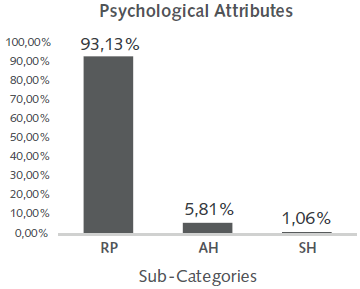
Figure 3 Preferences in Psychological Attributes. (RP) refers to Personality Traits, (AH) Interests/Hobbies, and (H) Sense of Humor.
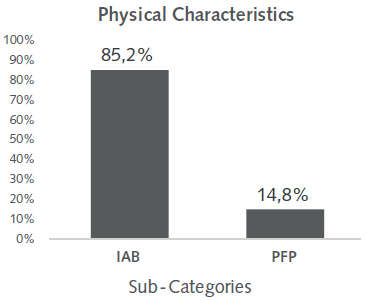
Figure 4 Preferences in Physical Characteristics. (IAB) refers to Biological Fitness Indicators, and (PFP) Particular Physical Preferences.
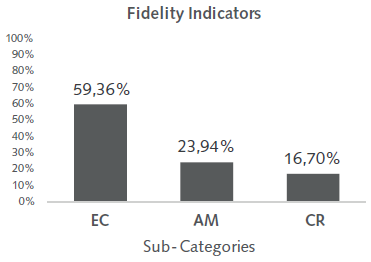
Figure 5 Preferences in Fidelity Indicators. (EC) refers to Marital Status, (AM) Moral Attitudes, and (CR) Religious Beliefs.
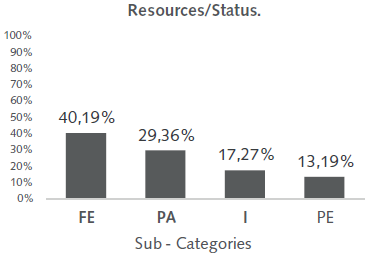
Figure 6 Preferences in Resources/Status. (FE) refers to Education, (PA) Spending Power, (I) Intelligence, and (PE) Earning Potential.
Finally, to evaluate the degree of selectivity between men and women at different ages, the arithmetic difference between the required and offered traits of each sex was calculated; in addition, the sample was segmented into different age groups covering a period of 10 years each (Range 16-65 years). Positive differences refer to subjects demanding more traits than they offer, and negative differences refer to subjects offering more than they ask for.
We observed that, on average, from 16 to 25 years, there are no significant differences in the demand for traits in relation to what is offered, in men and women (See Figure 9; u= 469.5; z = -0.215, p > .05; d = 0.05, r = 0.02). However, in the case of people aged 26 to 35, men tend to request more than what they offer (U= 41016.5; z = -2.445, P < .05; D = 0.21, R = 0.1), as well as men between 35 to 45 years of age (U= 19057; z = -2.141, p < .05; d = 0.21, r = 0.1). In contrast, from 46 to 55 years of age, no significant sex differences were found at the levels of demand (u= 3333; z = -0.218, p > .05; d = 0.025, r = 0.012), as well as between 56 and 65 years (U= 188; z = -0.276, p > .05; d = 0.17, r = 0.08).
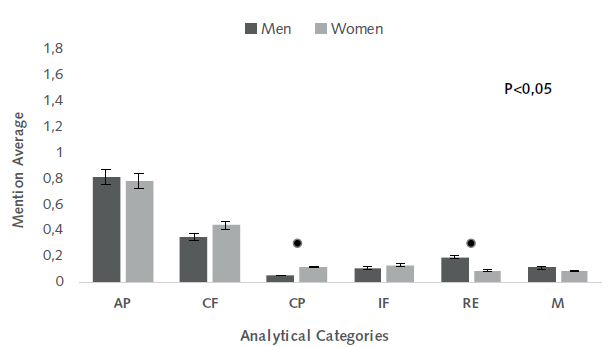
Figure 7 Offered Traits by each sex. Where (AP) refers to Psychological Attributes, (CF) Physical Characteristics, (RE) Resources/Status, (IF) Fidelity Indicators, (CP) Parental Commitment, and (M) Miscellaneous.
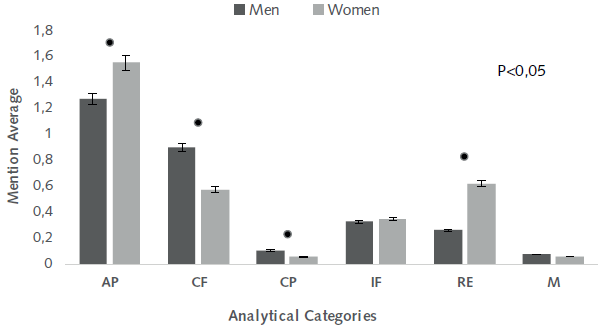
Figure 8 Required Traits by each sex. Where (AP) refers to Psychological Attributes, (CF) Physical Characteristics, (RE) Resources/Status, (IF) Fidelity Indicators, (CP) Parental Commitment, and (M) Miscellaneous.
When examining the differences in the cumulative frequencies between required and offered traits, women tend to mention more traits tan those offered in the 16-25 age range, while men make more mention of required traits than they offered in the 35-45 age range (See Figure 10).
Discussion
Mate preferences are a fundamental component in the evaluation of potential mates in the short- or long-term relationships, as they are at the base of the attraction process and the posterior courtship strategies. Mate preferences motivate individuals to make reproductive decisions that will have important consequences on their personal and partner's biological fitness (Moreno & Gutiérrez, 2021).
From the initial hypotheses proposed, we conclude for statement 1A (parental investment and indicators of genetic fitness), that the traits mentioned by the subjects were distributed according to what was reported in other studies (Burmann et al., 2002; Buss & Schmitt, 2019; Waynforth & Dunbar, 1995). Cues of parental investment and genetic fitness indicators were frequently offered and sought from potential mates. Although psychological attributes have not been extensively studied in research on lonely-hearts publications, in this case, they were the traits that most have caught the attention of advertisers; this bias towards psychological traits must be explored further because it may be an important domain for the competition to attract and select partners (Baize & Schroeder, 1995; Miller, 2011).
The implicit logic in this pattern is that individuals opting for long-term relationships should choose partners with permanent psychological qualities because other characteristics, as physical traits, devalue over time. A long-term investment in the partner should prioritize that the traits are stable enough to be 'exploited' or benefited from those qualities for a more extended time, as those psychological characteristics that promote strengthening the relationship, nurturing, or gathering resources. The theory of parental investment suggests that the couple's effort in the relationship should be maximized (Zahavi, 1975), and this effort can be translated into the quantity and quality of characteristics offered by the partners, in this case, the psychological traits would be an important way to contribute.
This idea seems to be contingent on the hypothesis that temporarily stable attractive traits are usually preferred over qualities that change their value over time (e.g., physical traits that change with aging). In that case, if we assume that the quality of psychological attributes has a constant value, in terms of time, it is possible to argue that preferences linked to these traits are an example of how humans optimize their decisions to maximize benefits in long-term relationships (Buss & Schmitt, 1993).
This predilection for psychological attributes might be an exaggerated pattern in humans, considering that behavioral and psychological variability is a characteristic of our species, and the individuals could compete to attract mates showing their psychological qualities. For example, personality traits may be indirect indicators of other domains of preference as social status or can be useful in a cultural environment where people are valued positively for being "cultured", "responsible", or "friendly" (Zentner & Eagly, 2015).
It is also consistent with the assumptions of the preference-priority model (Li et al., 2011), suggesting that individuals tend to prioritize traits associated with psychological and relational qualities (e.g., warmth and trust in the relationship) over other characteristics of their prospective mates. This indicates a hierarchical system linked to motivations for particular preferences, where psychological traits would play a central role in the mate selection process and the human' evolution. These hypotheses should be examined in more detail in the future.
Regarding prediction 2A (differences between offered and preferred traits), users demand more than they offer in terms of the number of characteristics mentioned in the ads. Demanding a larger number of quality traits can be considered an adaptive strategy because requirements and costs involved in long-term relationships are reasonably high and is possibly a way to compensate for those costs. Thus, it is essential to keep in mind that the aim is to maximize the parental investment of the mate, and one way to maximize this effort is to ask for high-quality traits or demand a wide variety of traits, which also contributes to the relationship (Zahavi, 1975).
Regarding premise 3A (sexual differences in offering and demanding traits), patterns of preference in the types of traits that men and women prefer in the pursuit of a permanent relationship were replicated; these same patterns are also present in other regions of the world (Buss, 1989; Buss & Schmitt, 2019). Specifically, we observed patterns associated with a higher offering of traits based on women's parental commitment, which is in line with the theory of sexual strategies. Women's interest in committing and investing in a relationship is a crucial offering due to their tendency to seek long-term relationships (Buss & Schmitt, 1993).
Similarly, the results showed another trend that is interpreted as a men's higher offering of resource/status traits. This pattern is significant because the resource/status category is one of the domains where men show stronger competition to attract women's attention (Burmann et al., 2002; Oda, 2001; Waynforth & Dunbar, 1995). It is the primary contribution that men have traditionally made in terms of parental investment linked to long-term mating (Buss & Schmitt, 1993; Miller, 1998; Shackelford et al., 2005).
It is interesting that women required traits linked to resources and status more than men; in that sense, the systems of preferences are mainly consistent with those offered by each sex, at least in this area, and this trend is replicated in studies with similar methodology (Burmann et al., 2002; Oda, 2001; Waynforth & Dunbar, 1995). The same situation occurred in the parental commitment category, where men required more traits of this nature compared to women. Therefore, it is reasonably clear that parental commitment may be an indicator of female attractiveness to men.
In addition, significant differences were found in the request of psychological attributes by women, that may indicate the need of demanding psychological traits with adaptive value or with high social appreciation; likewise, it is presumed that women evaluate the psychological characteristics of the applicants to achieve couples with whom it is "compatible" to relate, or as some social psychologists suggest, seek couples with similar and/or compatible personalities (Huston & Houts, 1998).
Moreover, men expressed more desire for physical characteristics than women. This pattern is evident in other studies (Buss, 1989; Shackelford et al., 2005; Waynforth & Dunbar, 1995), which is related to the hypothesis proposed in the theory of sexual strategies. According to the theory, men prefer physical traits because they are associated with fertility and the reproductive value of women in long-term mating. In these terms, it is productive to mate with women who can bear a larger number of healthy children, considering that men's parental investment would be optimized under these conditions (Buss & Schmitt, 1993). Given the 'sexy child' hypothesis, it is also conceivable that men would choose physically attractive women so that their children would inherit these traits and, in consequence, be attractive for other partners in the future (Miller, 1998).
As mentioned before, and consistent with claim 3B (consistency between preferred and offered characteristics of each sex), both men's and women's preferences and offers are contingent on each other. Specifically, men offer psychological attributes and resources/status, and women require these same categories, while women offer physical characteristics and parental commitment, and men find these characteristics highly desirable (See Figures 7 and 8). This correspondence has been proposed in the "compensation" or "trade-off" model, where men and women offer a variety of traits and values; in theory, the "agreement" would be an exchange of those values within the relationship. Socio-cultural theories have interpreted this exchange as a way to increase family wealth and social capital (Howard et al., 1987). On the other hand, evolutionary theories focus on understanding the value of offering critical characteristics to be invested in the relationship and nurturing future children (i.e., parental investment) (Buss & Schmitt, 1993).
The priority model argues that ideal couples would offer and supply different needs in certain dimensions (e.g., economic, social), depending on the psychological, physical, social, and material conditions of each individual. Additionally, they would provide equally valuable characteristics to both sexes in the relationship (e.g., commitment, fidelity) (Simpson & Gangestad, 1992; Li et al., 2002; Li et al., 2011).
In the present study, both sexes assigned greater importance to psychological attributes, while the discrepancies comparing the preferences of each sex were more prominent in categories as physical characteristics or resources and status. This is consistent with what was proposed in the exchange model and the priorities model, as mentioned previously (Li et al., 2011).
Regarding the last hypothesis 4A (sexual differences in selectivity), women became less and less selective over the years, whereas men, on average, were more demanding between the ages of 35 and 45. This pattern was similar to findings from other studies (Baize & Schroeder, 1995; Burmann et al., 2002; Oda, 2001; Waynforth & Dunbar, 1995), in which sex differences in mate selectivity depended on the advertisers' age (See Figures 9 and 10). This may result from changes in the personal attractiveness value experienced by each sex over the years. For example, there may be changes in the attractiveness value of physical characteristics in women due to the effects of aging. At the same time, there is an increase in some men's overall attractiveness value as they would accumulate more resources or status over the years.
In other words, a person who perceives a higher level of personal attractiveness over the years (offering more outstanding characteristics) will be more selective about potential partners (demanding more quality and quantity traits from the partner), and vice versa (Buss & Shackelford, 2008). These ideas have been explored by studying highly attractive women, who tend to be more demanding in a wide variety of preference dimensions (Buss & Shackelford, 2008).
The tendency to be more selective may also be expected on individuals who present high parental investment due to their physiological conditions in reproduction. For example, female mammals are more selective because they have to carry the cost of gestation, lactation, and child care (Zahavi, 1975); for this reason, selectivity in women may reach its highest peak in fertile ages (See Figure 7) (Buss & Shackelford, 2008).
In conclusion, this study offers an improved methodological framework to approach the study of mate preferences from qualitative data, especially in research on lonely-hearts advertisements. Also, it provides new regional data that complement the global findings on the phenomenon of human sexual preferences. By comparing the different domains of preference and how they are expressed in each sex, this study suggests that the attractiveness value of psychological qualities is a key component to understand preferences in long-term mating. This is not accomplished at all by other studies where the emphasis is on analyzing physical characteristics and indicators of social status and resources.
The present study has an exploratory/descriptive nature that limits the possibilities of control of the examined variables. Consequently, the explanatory scope might be restricted; however, considering that the data came from real contexts about human mating dynamics, we start from the advantage of ecological validity to make predictions about natural mating contexts. Similarly, it is important to consider that the reliability of the data is restricted, as there is limited control over the advertisers' sincerity; nevertheless, including personal data in the advertisements may give some confidence that they are real mate searching proposals.
It is necessary to consider other types of research that support the findings on long-term mating. It is recommended to take representative samples from different sources of information (e.g., newspapers, magazines, websites) to contrast the preference patterns in our species more accurately. With the arrival of new information technologies, it is possible and necessary to consider new ways of studying the complex dynamics of human sexual selection.
The authors received financial support for the present study from the Faculty of Human Sciences of the National University of Colombia through the Orlando Fals Borda Research Grant. We thank Nila Fernanda Amaya, Jhon Bustos, and Vanessa Mejía for their assistance in this project and the research group of the Animal Learning and Behavior Laboratory of the National University of Colombia for the logistical support













